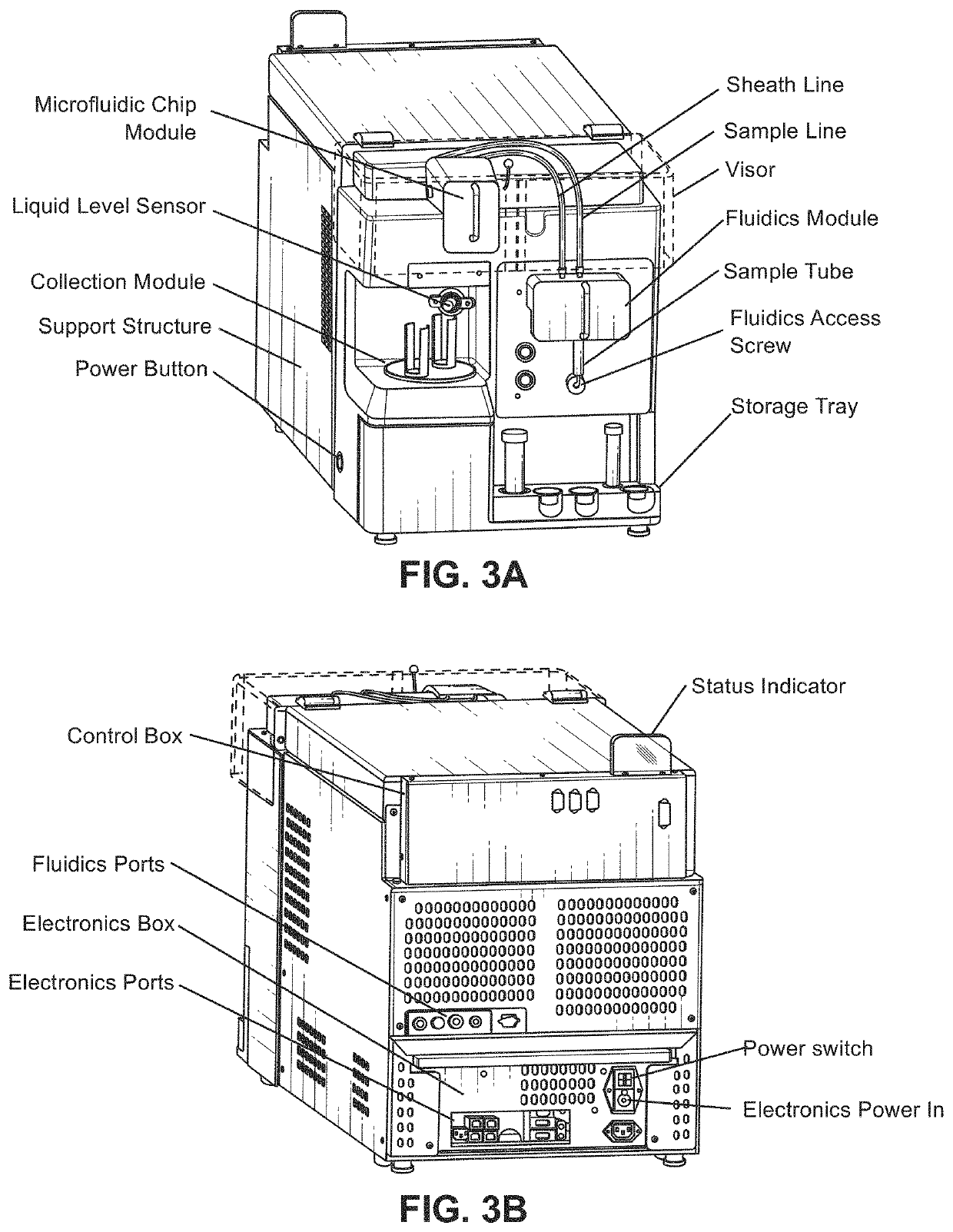Modular flow cytometry systems and methods of processing samples
a flow cytometry and module technology, applied in the field of modules of flow cytometry systems and methods for processing samples, can solve the problems of sample mishandling, contamination, overall error, and increased likelihood of incorrect system parameters or calibration, and existing systems and methods which rely primarily on human operators, and process are also subject to extended downtime and lengthy set-up and calibration steps
- Summary
- Abstract
- Description
- Claims
- Application Information
AI Technical Summary
Benefits of technology
Problems solved by technology
Method used
Image
Examples
example 1
[0299]Without wishing to limit the present invention to a particular application or embodiment, the following exemplary embodiment is provided.
[0300]A flow cytometry particle sorting system comprises a detection laser assembly, a microfluidic ship, a detection sensor, a set of signal processing electronics, a graphical user interface, a CCD camera, a kill laser module, and a kill sensor. The detection laser assembly is configured to excite a dye, such as a Hoechst dye, within a particle, which may be an individual sperm cell. The beam from the detection laser is focused to a specific size, such as an elliptical shape having a fast axis of 3.5-20 μm and a slow axis of 30-150 μm. The microfluidic chip accepts a particle sample, such as an ejaculate sample comprising sperm, and focuses or orients the particles using a sheath fluid within one or more microchannels in the chip. The detection sensor collects light emission at the detection laser location. The signal processing electronics...
example 2
[0304]Without wishing to limit the present invention to a particular application or embodiment, the following exemplary embodiment is provided.
[0305]Typically, pulsed lasers are used for fluorescing dye in a particle in a flow cytometry system. For example, existing systems for semen sexing in sperm may use pulsed lasers to fluoresce a Hoechst dye, such as Hoechst 33324, in a sperm cell to determine an amount, and therefore type, of DNA in a sperm cell in a sexing process. However, using a CW laser provides benefits in efficiency, calibration, and setup compared to traditional pulsed lasers. The use of CW lasers in the present invention provides said improvements over existing pulsed detection lasers and detection laser assemblies while maintaining the same fertility or viability of sperm cells sorted in this manner within a statistically significant margin of error. The conception rate as a measurement of fertility for cells irradiated by a CW laser was at least as good as, if not ...
example 3
[0306]Without wishing to limit the present invention to a particular application or embodiment, the following exemplary embodiment is provided.
[0307]A laser-based particle detection and deactivation system comprises a kill laser assembly and a detection laser assembly. The kill laser assembly may operate at a power of 350 mW to 2 W. The power of the detection laser assembly may be set from 10 mW to 50 mW. Power delivered by the detection laser assembly can incur a power loss of approximately 10% and a measured power drift over a 24-hour period of less than + / −1%. Accurate and steady detection laser power may be achieved by increasing laser power over a first minute of operation and lowering laser power thereafter to provide for stable detection power with an increased temperature of approximately 4 degrees Celsius.
[0308]With reference now to FIG. 29A and FIG. 29B, respective views of representative graphical user interface outputs measuring a detection laser beam size and intensity ...
PUM
| Property | Measurement | Unit |
|---|---|---|
| width | aaaaa | aaaaa |
| width | aaaaa | aaaaa |
| width | aaaaa | aaaaa |
Abstract
Description
Claims
Application Information
 Login to View More
Login to View More - R&D
- Intellectual Property
- Life Sciences
- Materials
- Tech Scout
- Unparalleled Data Quality
- Higher Quality Content
- 60% Fewer Hallucinations
Browse by: Latest US Patents, China's latest patents, Technical Efficacy Thesaurus, Application Domain, Technology Topic, Popular Technical Reports.
© 2025 PatSnap. All rights reserved.Legal|Privacy policy|Modern Slavery Act Transparency Statement|Sitemap|About US| Contact US: help@patsnap.com



